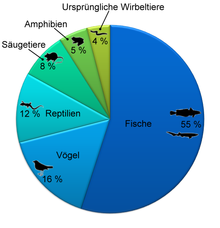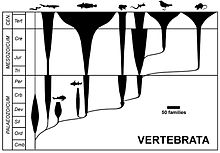Vertebrate
![]()
Vertebrata is a redirect to this article. For the algal genus of the same name, see brush tuft alga.
Vertebrates are chordates with a vertebral column. This subphylum includes five major groups traditionally listed as classes: Fishes (bony and cartilaginous fishes), amphibians, reptiles and birds, mammals, and, as primitive representatives, in addition, the cyclostomes. They are contrasted with the informal group of invertebrates or invertebrates (these are all other animals), which have no vertebral column.
Today, many zoologists prefer the term craniota for this taxon. This view takes into account that the cyclostomes, like some other vertebrates, do not have a vertebral column as an axial skeleton, but a chorda dorsalis. But common to all vertebrates is an ossified or cartilaginous skull; its presence is thus one of the commonly derived features (synapomorphies) of this chordate group.
Floor Plan
Vertebrate monophyly is supported by a set of common derived (new) basic plan features (synapomorphies):
- Multi-layered epidermis: The epidermis differentiates into several superimposed cell layers. Within vertebrates, the "skin" with several layers and associated structures such as scales, feathers, etc. is formed.
- Neurocranium: The brain and the large sensory organs are protected by a capsule (cranium).
- Neural crest: An embryonic structure composed of pluripotent cells that arise from the ectoderm at the boundary between the epidermal ectoderm and the neural ectoderm. They form, among other things, skeletal structures of the head, pigment cells, neurons such as Rohon-Beard cells, ganglia and odontoblasts.
- Placodes: thickenings of the embryonic epidermis. Cells of the placodes are involved in the formation of neural organs.
- Inner ear: seat of the organ of equilibrium
- Brain: The anterior part of the neural tube is differentiated into a (multi-part) brain.
- Cerebral nerves: In the basic plan, ten nerves of a completely different nature, which connect the brain with the periphery. They are present quite constantly throughout the vertebrates.
- Vascular system: The cardiovascular system is a self-contained system (almost completely).
- Kidneys: Central urinary organ (excretory organ) of vertebrates.
- Vertebrate eyes: highly developed and complex sensory organ for the perception of optical stimuli
- Spinal ganglia: Ganglia can be assigned to the spinal nerves.
Systematics
External systematics
The vertebrates have the rank of a subphylum in conventional biological systematics. Together with the tunicates and the species-poor skulls, they form the phylum Chordata.
According to the Notochordata-Urochordata hypothesis, the vertebrates are considered to be the sister group of the skullless animals (Acranians/Cephalochordata), hence they are often referred to as "skull animals" (Craniota or Craniata). In contrast, the alternative Olfactores-Cephalochordata hypothesis, which appeared later, states that the mantle animals (Urochordata/Tunicata) are the sister group of vertebrates. Which hypothesis is correct is still not clear today.
Inner systematics
In the past, vertebrates were subdivided according to the criterion of whether or not they had jaws. This approach is outdated: the jawed (jawed animals) are no longer contrasted with the jawless (Agnatha), but with the round jawed (Cyclostomata).
However, the internal systematics of vertebrates remains controversial, particularly the question of whether there is a sister group relationship between jawed mouths and lampreys, or between hagfishes and lampreys:
Hagfishes + (jaws + lampreys)
(hagfishes + lampreys) + pine mouths
The following representation also takes extinct groups into account. The classic large groups are highlighted in bold.
Vertebrates (Vertebrata): over 70,300 species
- cyclostomes (Cyclostomata) about 131 species
- Hagfishes (Myxini): about 83 species
- lampreys (Petromyzontida): about 47 species
- "Ostracodermi" † (paraphyletic).
- pine mouths (Gnathostomata): over 70,200 species
- Placodermi † (paraphyletic)
- Acanthodii † (paraphyletic)
- cartilaginous fish (Chondrichthyes): about 1227 species
- Bony fish (Osteichthyes) (paraphyletic)
- Ray fins (Actinopterygii): over 33,400 species
- Meat fins (Sarcopterygii): 8 species
- terrestrial vertebrates (Tetrapoda): over 35,600 species
- Amphibians (Amphibia): over 7,800 species
- Amniotes: over 27,800 species
- Sauropsida
- Reptiles (Reptilia) (paraphyletic): about 10,700 species
- Birds (Aves): about 10,700 species, in addition 158 species have become extinct in historical times
- Mammals (Mammalia): about 6,400 species, in addition 96 species have become extinct in historical times
Extinct groups
The extinct, often heavily armored, jawless taxa are grouped together as Ostracodermi, the armored, jawed ones as Placodermi. However, both groups are not monophyletic taxa, nor are the Acanthodii, which are partly basal to cartilaginous fishes or to bony fishes.
The affiliation of the extinct conodonts to the Vertebrata is controversial.

Diversity of recent vertebrates: proportions of groups in the total number of species. "Fishes" = bony and cartilaginous fishes.

Vertebrate evolution since the Cambrian according to Benton (1998). Extinct are the Placodermi and the "spiny sharks". The width of the branches illustrates the number of vertebrate families, which, however, only gives an approximate indication of the respective species diversity. In particular, the species richness of the Mesozoic reptiles is not sufficiently evident. Also, the large number of newly discovered amphibian and reptile species to date is not yet reflected here
Questions and Answers
Q: What is a vertebrate?
A: A vertebrate is an animal with a spinal cord surrounded by cartilage or bone.
Q: What are animals that are not vertebrates called?
A: Animals that are not vertebrates are called invertebrates.
Q: What parts make up the vertebrate skeleton?
A: The parts of the vertebrate skeleton include the braincase, which protects the brain, a series of short, stiff vertebrae separated by joints to protect the spinal cord, bones to support and protect soft tissues and provide points for muscle attachment, and gill arches in some species to support their gills.
Q: What types of animals are examples of vertebrates?
A: Examples of vertebrates include mammals, birds, and fish.
Q: How many species of vertebrates have been identified?
A: A few tens of thousands of species have been identified.
Q: How many different kinds of fish exist as part of the Vertebrata class?
A: The term "fish" is used to describe at least four different kinds of vertebrates.
Search within the encyclopedia